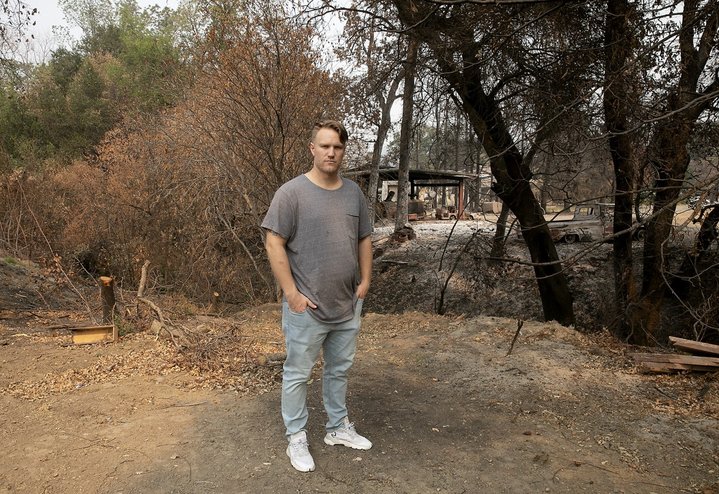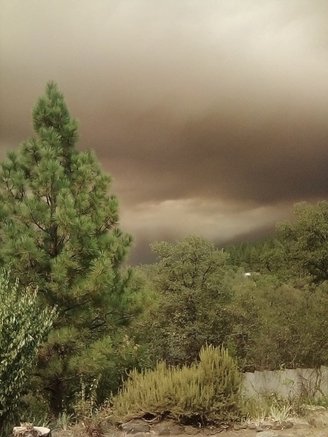
Taylor Craig stands on the edge of his family’s property outside of Vacaville on Oct. 2, 2020. Charred trees on the adjoining property were caused by the LNU Lightning Complex Fire in August; Craig was able to fight off the flames and protect his home from the fire after not receiving any evacuation warnings. Photo by Anne Wernikoff for CalMatters
###
Tracey Aldrich had never heard of CodeRED, Butte County’s opt-in emergency notification system, until she came upon a roadblock leading up to her mother’s house in August. At the roadblock, police told her a firestorm was bearing down on her mother’s neighborhood in Berry Creek. Neither she nor her mother had received any evacuation warnings.
Aldrich’s 70-year-old mother needed help escaping but the only road was closed, so Aldrich asked sheriff’s deputies to escort her mother off the mountain. Her home survived with minor damage from the flames. But the harrowing experience last month left both mother and daughter shaken and frustrated that they were never alerted to the fast-approaching North Complex Fire, which killed 15 people in Berry Creek.
“She had no warning,” Aldrich said. “If I wouldn’t have been on my way to her house, she would have never known, and the fire would have ripped through there.”
My mother “would have never known, and the fire would have ripped through there.”
— Tracey Aldrich, Butte County resident
A CalMatters review reveals that the systems that warn Californians about emergency evacuations have dangerous drawbacks. Millions of residents are relying on alerts that may never arrive because they didn’t know they needed to sign up for them.
Aldrich and her mother assumed, as do many cell phone users, that they are automatically enrolled to receive evacuation alerts in the event of a natural disaster.
But this is a common misconception. On one hand, most California counties do send cell phone alerts to people when wildfires are approaching and their neighborhoods are evacuated. But those alerts won’t arrive if their cell service is poor or they don’t have compatible cell phones.
To increase their chances of receiving local alerts, people need to actively register with their county. But very few Californians have done so.
In at least 13 fire-prone counties, less than 25% of adults are signed up for opt-in county emergency alert systems, according to a CalMatters review of the 25 counties that have suffered the state’s largest and deadliest wildfires. These systems send texts and emails and also phone people to warn them to evacuate during disasters like wildfires.
“You’ve got to sign up and, frankly, very few people do.”
Ken Dueker, Palo Alto’s Office of Emergency Services
Some of the state’s most vulnerable residents — elderly, non-English speakers and disabled, low-income and undocumented people — may be the ones least likely to sign up. That could leave them without alerts to evacuate, despite being among those who need the most advance warning.
“You’ve got to sign up and, frankly, very few people do,” said Ken Dueker, Palo Alto’s Office of Emergency Services director. “I don’t blame them because they don’t know about the tool — they falsely assume the government has these magic, omniscient powers to notify.”
“The public expects us to have more improved tools and more finesse than we currently do.”
In some cases, the failure to alert people has turned fatal, including during 2018’s Camp Fire, the deadliest wildfire in California history.
California’s opt-in warning systems are “totally inadequate and totally inaccurate,” said State Sen. Hannah-Beth Jackson, a Santa Barbara Democrat who chaired the Legislature’s emergency management committee in 2017 and 2018.
“We find that most people, probably over 50% of people, do not opt in,” she said. “A lot of people, they don’t take the time, they don’t think they have the interest.”
Few people enrolled in alerts
Even in counties that have experienced the state’s largest and deadliest firestorms, a majority of residents have not signed up for emergency alerts, according to data provided by county officials.
For instance, in Sonoma County, scorched by the 2017 Tubbs Fire that killed 22 people, only 20% of adults are signed up for the county’s emergency alerts. In Solano County, only 13% have signed up for Alert Solano.
Only 1% of adults in Fresno County — where the Creek Fire has destroyed more than 850 structures and is still burning — have signed up for alerts, as well as only 1% of the 7.9 million adults in Los Angeles County, which includes fire-prone Malibu and the San Gabriel foothills. In San Joaquin, Alameda and Santa Clara counties, it’s 6%, leaving millions of people in these counties unenrolled.
(Some cities within those counties have their own alert systems, so residents may be signed up for those, which are not included in the percentages.)
A few counties have fared better, although tens of thousands of people still aren’t enrolle there: In remote Mendocino County, 80% of adult residents have signed up, in Yolo County, 70%, and in Butte County, where 86 people died in the town of Paradise two years ago, 68%, according to county officials there.
Officials in one of the 25 fire-prone counties contacted by CalMatters — Contra Costa County — did not respond to requests for comment, and Lassen County could not provide the total number of registrants.
Sarah Johnson, who lives at the Emerald Hills Horse Ranch in Yolo County, said she only learned about her county’s opt-in alert system one day before she had to escape from the LNU Lightning Complex fire.
“The day before, I was trying to find more information on the fires, and I just happened to stumble upon the opt-in system, so I had no idea about it, prior,” she said. “It’s very concerning that emergency alerts would be opt-in only.”
She said she hopes the state will eventually move towards a universal system that registers everyone automatically, rather than leaving it up to counties to enroll residents.

Smoke filled the air in Berry Creek as Tracey Aldrich raced to evacuate her mother. Neither of them received any county evacuation alerts. Photo courtesy of Tracey Aldrich
Aldrich, the Butte County resident whose mother had to evacuate, said her experience opened her eyes to the fact that many of California’s most vulnerable residents — the elderly and those with disabilities — might not be signed up to receive emergency alerts.
“I don’t believe that everybody does have an idea about it, and if they do, they’re either elderly or don’t know how to sign up,” she said. “My mom, she knows how to use Facebook and that’s about it.”
Lt. Stephen Collins, Butte County Sheriff’s Office emergency manager, said “we encourage community members to sign up for CodeRed but ultimately it is up to the individual community member to sign up.”
Counties’ efforts to inform residents to sign up often rely on word-of-mouth or social media. San Mateo County Emergency Services Coordinator Jeff Norris said the county typically sees a large increase in signups following a major emergency. Bay Area counties are planning a joint advertising campaign on social media, he said.
Systems ‘just all failed’
Even people who are signed up to receive alerts don’t always receive them.
Taylor Craig said he’s enrolled in all of Solano County’s opt-in alert systems, so as the LNU Lightning Complex fire raced towards his Northern Vacaville farm on Aug. 18, his family’s plan was to stay in place until he heard from the authorities.
Power shutoffs, designed to reduce the risk of sparking fires, can shut down cell towers.
“That is the known way of communication in these sort of emergency situations,” he said. “I get messages from Solano County, like, three times a week on the regular, so it was expected.”
Craig said he received phone alerts until about 4 p.m. the day of the fire. But then the communication from the county went dark.
“At midnight, the glow of the fire was a quarter-mile away from us, and I look up and see it’s completely, the sky is red,” he said. “And I was like, ‘oh, boy, we’re not going to get a warning, it’s not happening — there will not be an evacuation warning whatsoever.’ ”
“That was extremely frustrating to see that the systems you expect are going to kick in, just all failed,” he said.
He said he and his family managed to escape just minutes before the fire reached his property, which burned to within six inches of his house. More than 1,400 structures were destroyed in the blaze.
Cell service or power disruptions may have been the reason Taylor was not alerted.

Horses are in their enclosure on Taylor Craig’s farm outside of Vacaville on Oct. 2, 2020. Because the fire was so close to his property, the horses were too spooked to be evacuated during the LNU Lightening Complex Fire, Craig said. He was forced to tear down the fence and let the horses free to save them. Photo by Anne Wernikoff for CalMatters
Le’Ron Cummings, a spokesperson for the Solano County Sheriff’s Office, said that alerts were sent out in Craig’s area, but they may have been compromised by disruptions to cell service and power.
“Unfortunately, we cannot guarantee the targeted population has cell service, phone not on silent and nearby, or an internet or landline signal,” Cummings said in an email. “This is also why we follow up with door-to-door and siren notifications by law enforcement.”
Craig said he never received a door-to-door notification. He said his mother drove down the road to speak with fire personnel and was then told to evacuate.
Last month in Berry Creek, where Aldrich and her mother received no alerts, Butte County sent notifications through both the opt-in CodeRED system and a federal system that messages all compatible cell phones, according to Collins, the sheriff’s emergency manager.
However, some residents may not have received the automatic notifications due to poor cell reception and public safety power shutoffs, he said.
Power shutoffs, designed to reduce the risk of sparking fires, can shut down cell towers. Recognizing this, the California Public Utilities Commission voted unanimously in July to require wireless carriers to provide 72 hours of backup power to their towers in fire-prone regions. Carriers opposed the move.
“At midnight, the glow of the fire was a quarter-mile away from us […] and I was like, ‘oh, boy, we’re not going to get a warning.’”
— Taylor Craig, Solano County resident
Megan Daly, a spokesperson for AT&T, one of the state’s largest cell service providers, said the company’s network held up well during the wildfires and power shutoffs, and that customers were warned before their power went out. She said “no county operated below 98% of normal” during a recent power shutoff.
Brain Ferguson, a spokesperson for Cal OES, the state Office of Emergency Services, said the agency does not require counties to expand their opt-out systems and has no clear authority to implement a statewide system.
“But certainly, we’re constantly looking at what resources exist, and how we can implement alert and warning as well as any other sort of emergency response capability in a manner which keeps the most people safe,” he said.
Built for the landline era
Emergency alert and warning systems have become increasingly controversial as California’s wildfires become larger and more destructive. Legislators promised improvements after the 2017 Wine Country fires, in which 40 people were killed and many residents received little or no warning that a fire was bearing down on them.
This led to the creation of a new set of statewide warning guidelines, which were published in March 2019.
Many of the guidelines indicate that California’s alert and warning system was largely built in the age of landlines and Cold War air raid sirens. Suggestions include utilizing church bells and foghorns to warn residents of danger.
Counties still maintain lists of landline customers, which they input into a reverse 9-1-1 system that can call all addresses in a specified geographic area during an emergency. The National Center for Health Statistics found last year, however, that less than 40% of households have a landline, with even lower percentages among young people.
“We see that number declining every month, as more people are going away from landlines to an all-cellular or a voice over IP phone strategy,” said Norris of San Mateo County.
Residents who give up their landlines should enroll in their county’s opt-in systems so their new number is on file, he said.
For those who haven’t enrolled, there is only one option to alert them to wildfires: the federal Wireless Emergency Alerts system, which also sends AMBER Alerts and severe weather warnings. Launched in 2012, the WEA system pings newer models of cell phones with a distinct tone and vibration. Users of compatible phone models are automatically enrolled, though the alerts can be easily disabled.
The WEA system does have significant shortcomings, however, Norris said. The county opt-in systems can target numbers associated with specific addresses inputted by residents when they register. But the WEA messages go out to everyone connected to a cell tower in a certain area.
“The opt-in data gives us the most specific information and the most delivery methods — the ways that we can get the message to people — so we’re always going to be able to reach an individual better with opt-in data,” Norris said.
Counties can only use the federal system for severe, life-threatening circumstances. That means residents might receive earlier warnings through the county opt-in systems.
For those who haven’t enrolled, there is only one option to alert them to wildfires: the federal Wireless Emergency Alerts system, which also sends AMBER Alerts and severe weather warnings.
“If there’s an, ‘oh my god, the sky is falling, everybody’s going to die,’ kind of an alert that has to go out, we would use IPAWS to send that message out,” Kerry John Whitney, Napa County’s emergency services manager, said. WEA is part of the Integrated Public Alert & Warning System (IPAWS).
Whitney said, for instance, he might use the county’s opt-in system to warn residents of a potential danger eight to 12 hours in advance.
After its 2017 wildfire, Sonoma County faced heavy criticism for its decision not to send a Wireless Emergency Alert to residents. Emergency managers there feared that such a message would cause panic and disrupt evacuations, a state report found. The county has since replaced its emergency manager and promised improvements.
Some counties don’t even have access to WEA alerts, meaning they rely exclusively on landline numbers and residents who sign up for alerts. Yuba County, which evacuated residents during the North Complex fires last month, is in the midst of applying for access to the system, according to county spokesperson Russ Brown called a “long process.”
A FEMA spokesperson said Monday that a backlog of more than 400 applications from local governments was cleared in early 2019, with processing times now down to two weeks.
Fixes are ‘slow going’
California has enacted several rules in recent years to expand county systems so that residents don’t have to sign up to get alerts.
Authored by Jackson, Senate Bill 821 in 2018 allowed counties to reach agreements with utility providers to automatically add customers’ phone numbers to their alert systems, with an opt-out option.
Under an expansion signed into law last month, cell phone companies were added, which emergency managers said will be a huge help in enrolling residents. And cities and universities can now also enter into agreements with utility providers.
Also, counties can now use information from social service agencies to enroll people with accessibility problems or disabilities in county alert systems. Before the law was signed, counties could access those lists of vulnerable residents only during a life-threatening emergency.
Counties can now use information from social service agencies to enroll people with accessibility problems or disabilities in county alert systems.
Still, none of those changes are a silver bullet in getting people enrolled, said San Mateo County Supervisor David Canepa. He has pushed for expanding the county’s automatic enrollment in emergency alerts as chair of its Emergency Services Council.
“It’s been slow going and frustrating, to be honest,” he said, pointing to the significant workload in maintaining the contact lists.
The new rules also don’t work as well in rural counties where there tend to be many utility companies and some customers live off the grid.
“I’d have to hunt down 130 different utilities,” Mendocino County Emergency Services Coordinator Brentt Blaser said.
Assemblymember Monique Limón, a Santa Barbara Democrat who authored the expansion bill with Jackson, said legislators have had long conversations about opt-in and opt-out systems, and “there’s an interest to get more folks to the opt-out column.”
She said counties, law enforcement and state emergency officials support expanding the categories of opt-out, but the transition has not been easy.
“We can’t pass a law that says, every phone is going to get this. There’s some issues in terms of the carriers, the privacy…the coordination also at the federal level,” Limón said. “It’s been the troubleshooting of how you make that real that has been more an issue than an overall resistance from all of those involved in natural disaster response.”
###
CALmatters.org is a nonprofit, nonpartisan media venture explaining California policies and politics.
CLICK TO MANAGE